Geography Reference
In-Depth Information
0
500
1000 mi
0
500
1000 km
Shanghai
East
China Sea
BHUTAN
WEST
PAKISTAN
1947
MACAO
1999
INDIA
1947
Canton
FORMOSA
1945
BURMA
1948
HONG
KONG
1997
LAOS
1954
Diu
Pacific
Ocean
EAST
PAKISTAN
1947
Arabian
Sea
SIAM
PHILIPPINES
1946
Goa
Bay of Bengal
CAMBODIA
1954
South
China Sea
Pondicherry
CEYLON
1948
BRUNEI
1959
MALDIVE
ISLANDS
1965
FEDERATED MALAY
STATES 1963-1965
SINGAPORE
1959-1965
1947
Date of independence
New political divisions at independence
British
British influence
French
Dutch
American
Portuguese
Japanese
Not a colony
INDONESIA
1949
Indian Ocean
EAST
TIMOR
1999
Figure 1-14
Most of Asia was either colonized or strongly influenced by foreign powers, with the exception
of Thailand, which served as a buffer between English and French interests in Southeast Asia.
The Philippines was a Spanish colony from 1565 to 1898 and an American one thereafter .
Formosa (T (Taiwan) was a Japanese colony from 1895 to 1945. Although China was never a
colony , many places such as Canton (Guangzhou) and Shanghai had foreign concessions.
was in full swing elsewhere. Some saw potential for the
island nation as the “Britain of the Pacific.” Why could
Japan not have a colonial empire? After all, it needed raw
materials for industrialization and space for expansion.
Japan flexed its muscles, attacking and defeating both
China and Russia at the turn of the century . China' s island
of Taiwan (1895) and footholds on the mainland were the
rewards of victory . Japan' s empire was taking shape. Korea
was annexed in 1910. Japan' s territorial ambitions were
fervently pursued in China, and by the mid-1930s, Japan
dominated a vast empire (Figure 1-14).
Japan' s ambition was to establish a
Greater East Asia
Co-Prosperity Sphere (GEACPS),
incorporating Asians
minus the European imperialists. As it defeated both in-
digenous and colonial forces, it propagated the slogan
“Asia for the Asians.” Its grandiose plans were foiled
when it drew the United States into the Pacific theater of
war by bombing Pearl Harbor, Hawaii, on December 7,
1941. By 1942, Japan controlled all of the northern Pacific
west of the international date line. Japan then dominated
100 million people!
After its defeat in 1945, Japan was relieved of all its
colonies, but the GEACPS had left a legacy: Japan had
been the vanguard of Asian nationalism. “Asia for the
Asians” became a cornerstone of independence struggles.
But new socioeconomic-political theories were on the
horizon to shape the entire process.
Decolonization and Independence
European imperialism began to crumble under the
weight of independence movements before and after the
first World War. After World War II (1939-1945), it
crashed. During the process of
decolonization,
inde-
pendence was both negotiated and fought for. Countless
lives were sacrificed. France, which was the most resist-
ant to giving up its colonies, lost 95,000 persons between













































































































































































































































































Search WWH ::

Custom Search